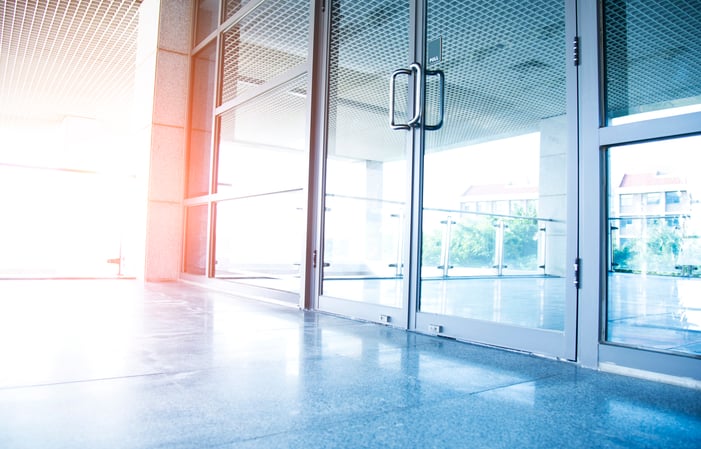Commercial glass types often used for exterior doors include:
|

Commercial glass does more than just fill a frame; it invites light to dance across your foyer or mall, provides a portal for those inside to gaze out, and enhances a building’s overall appeal. The role of glass in these doors is as functional as it is aesthetic.
The choice of glass reflects a door's style, endurance, and safety, influenced by its placement and purpose.
It begins with selecting the right type of glass to harness the potential of commercial glass doors, particularly those gracing storefronts. This careful choice sets the stage for a door that looks spectacular and performs impeccably over time.
4 Commercial Glass Types for Exterior Doors
With a wide variety of options, there’s a glass type for almost every commercial door.
Commercial glass types often used for interior commercial spaces include:
- Tempered glass
- Laminated glass
- Decorative glass
Each type of commercial glass has advantages and disadvantages, so it’s important to understand which one best suits your situation before selecting the right material.
1. Tempered Glass
Tempered glass is among the strongest glass options available. Through a heat-treating process—which heats panes to over 1,000℉ before quickly cooling them—glass sheets become 4-5 times stronger than traditional glass.
With its increased strength, tempered glass is more durable and can deflect blunt impacts without breaking commercial glass doors. In case of a breakage, temporary glass doesn’t shatter into jagged shards. Instead, it breaks into small, pebble-like pieces, ensuring that those in the immediate area of a broken tempered glass pane are not at risk of getting hurt by large pieces.
Tempered glass is heat resistant, shielding it from intense fire. Its strength and security make it ideal for high-traffic areas.
2. Laminated Glass
Another material known for strength in commercial glass doors is laminated glass panes, which also stand up well to the demands of a door. Made by bonding a clear vinyl interlayer between at least two plies of glass, laminated glass panes offer increased integrity against heavy or direct blows.
Also, laminated glass can be bulletproof by incorporating a special polycarbonate layer, providing exceptional security in sensitive environments. If the glass does break, its pieces don’t shatter and fall out of place. Thanks to the interlayer, broken glass pieces remain within the pane, drastically reducing the chance of injury from jagged shards.
With its additional layers, laminated glass reduces noise, an important feature for busy streets and thoroughfares spaces.
This combination of strength, safety, and sound insulating properties makes laminated glass a versatile choice for many commercial applications.
3. Decorative Glass
Not all doors serve purely practical functions; often, they play an important role in improving a building's aesthetic appeal. This is especially true for doors in historic buildings or restoration projects, which can significantly contribute to a structure’s character.
Incorporating patterned glass into a design can achieve effects and, depending on the pattern, can offer privacy by obscuring visibility. For commercial glass entry doors, aligning them with historical styles while selecting fitting patterned glass ensures they integrate seamlessly with the architecture.
Concerns about durability? Many patterned glass types can be tempered.
In contemporary settings, two-way mirror glass, like Mirropane, offers a distinctively modern aesthetic. It eases light transmission and allows clear views from one side, making it stylish and functional.
Resource: Consult with your glass manufacturer
to explore more patterned glass options.
Commercial Glass Door Insights: Your Quick FAQ GuideHow does the choice of glass impact the overall safety and security of a commercial building? The type of glass used in commercial doors can significantly influence building safety and security. Tempered glass reduces injury risk by breaking into small, blunt pieces, while laminated glass holds together even when shattered to prevent easy entry. Are there any special maintenance requirements for different types of commercial glass doors? Yes, different types of glass require specific maintenance to ensure longevity and performance. Tempered and laminated glasses should be regularly cleaned with suitable cleaners to avoid scratches and preserve clarity. For laminated glass, inspecting the edges for signs of delamination is important, which can compromise the glass's structural integrity. |
Elevate Your Entrance: Mastering Commercial Glass Door Aesthetics
Explore a world of possibilities with commercial glass doors: Whatever your priorities—functionality, safety, security, or style—there's a glass door to match.
Choose from a large selection, including tempered glass for durability, fire-rated glass for safety, laminated glass for security, and decorative glass to elevate your space's aesthetic. Find the perfect solution tailored to your needs.
See What We Offer
Grab your free digital copy of our catalog to learn more about the various styles available for commercial glass doors:
(Editor's note: This article was originally published in January 2021 and was recently updated.)



